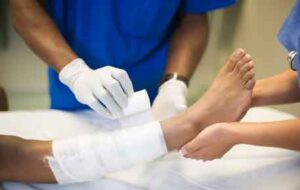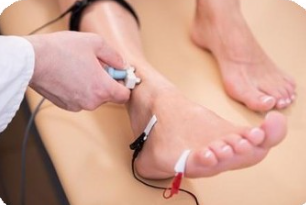Podiatrist’s Role in Healing Lower Extremity Wounds After Mohs Surgery
September 10 2024
Struggling with wound healing after Mohs surgery on your lower extremities? 🦶 Podiatrists provide personalized care along with the latest technology to help heal lower extremity wounds faster and reduce infection risks. 💼✨ #WoundCare #Podiatry #MohsSurgery #FFLC

OVERVIEW:
1. Mohs Surgery
2. Wound Care
3. Progress and Risks
4. Advanced Wound Care Techniques
Mohs Surgery is a specialized procedure used to treat skin cancer by removing thin layers of skin one at a time and examining each layer under a microscope until all cancerous tissue is gone. This technique allows for complete cancer removal while preserving as much healthy skin as possible. It is highly effective for treating basal cell carcinoma, squamous cell carcinoma, certain melanomas, and other skin cancers, with success rates as high as 99%.
Post-Mohs Surgery Wound Care
Once the cancer is removed, the wound left behind can either be closed with sutures or left to heal on its own – a process known as healing by secondary intention. Here’s an overview of the options:
– Suture Closure:
• Used when scarring need to be minimized or the wound is too large for natural healing.
• Surgeons may also use nearby tissue or a skin graft for reconstruction.
– Healing By Secondary Intention:
- Ideal for smaller wounds or those in less visible areas
- Can take 6-12 weeks or longer to fully heal
- The wound heals from the edges and base, gradually filling with healthy tissue.
While healing by secondary intention may result in a wider, more visible scare, it’s often the best option for certain types of wounds.
Healing Progress and Ricks
The expected healing timeline for wounds is that they should close by approximately 50% within the first 4 weeks. If the wound does not reach this benchmark, it may be classified as a chronic wound, which could require more advanced treatment options to facilitate healing.
Infection risk is higher for wounds that are left to heal naturally, particularly due to the longer healing period involved. Providing swift and attentive care during these first 4 weeks is essential to reduce the risk of infection and ensure proper recovery.
Podiatrists’ Role in Wound Care

Podiatrists play a critical role in managing wounds on the lower extremities, especially after procedures like Mohs surgery. Their specialized expertise allows them to approach wound care holistically and ensure that healing is as efficient as possible.
– Personalized Treatment: Every wound is unique, and a podiatrist begins by thoroughly assessing the wound’s size, location, and the patient’s overall health. This includes evaluating underlying conditions like diabetes or vascular issues that may affect healing. By considering these factors, podiatrists can develop a tailored treatment plant that meets the specific needs of each patient and maximizes the chances of a successful recovery.
Multifaced Approach: Podiatrists utilize a comprehensive approach to wound healing, focusing on four crucial aspects:
1. Vascular Health: Ensuring proper blood supply to the wound site, as poor circulation can hinder healing.
2. Dermatologic Health: Monitoring the condition of the skin and wound to prevent infections and ensure proper care.
3. Orthopedic Considerations: Assessing the impact of bones and tendons around the wound to avoid any pressure or movement that may delay healing.
4. Neurologic Function: Evaluating nerve health, particularly for patients with conditions like diabetes, to ensure sensory deficits are managed effectively.

In more complex cases, podiatrists may collaborate with other specialists to ensure comprehensive care and optimal recovery outcomes.
Advanced Techniques in Would Healing
At Family Foot and Leg Center, podiatrists are committed to using the latest advancements in wound care to promote healing. Regular debridement of the wound, which removes nonviable tissue, is essential to stimulate blood flow and encourage the formation of healthy tissue. Advanced interventions may also be used when standard care doesn’t produce the desired results, ensuring the best possible outcome for patients.
If you have a wound following Mohs surgery, the expert podiatry team at Family Foot & Leg Center is  here to help. With advanced wound care techniques and personalized treatment plans, we’ll guide you through the healing process. Contact us today to schedule an appointment and start your path to recovery.
here to help. With advanced wound care techniques and personalized treatment plans, we’ll guide you through the healing process. Contact us today to schedule an appointment and start your path to recovery.
If you or someone you know has a wound that is not healing, don’t hesitate to seek professional advice from a podiatrist, contact Dr. DeBlasi’s office at (239) 430-3668 (FOOT) or visit www.NaplesPodiatrist.comhttps://www.naplespodiatrist.com/ to schedule an examination.

 Fax: (239) 692-9436
Fax: (239) 692-9436 Tel: 239-430-3668
Tel: 239-430-3668

